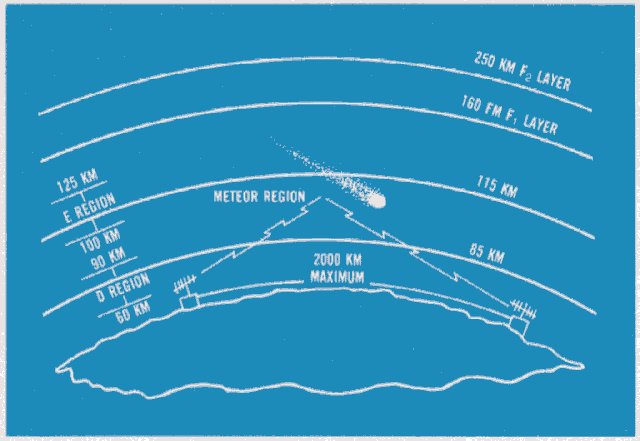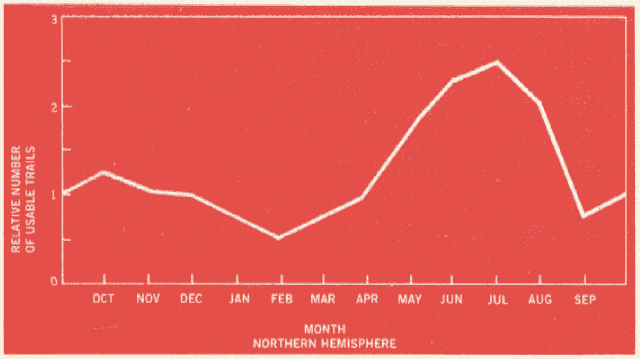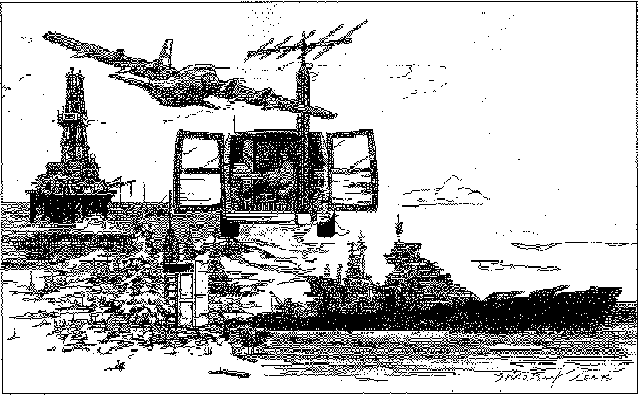
Meteor Burst Communications
Application for National Security Operations

For decades, ionized trails left by tiny particles, similar to grains of sand, bombarding the Earth's atmosphere have stimulated the imagination of communicators. Following expanding interest in the 1940s, a number of definitive studies in the 1950s and 1960s explored the manner in which those trails could be used as a telecommunications medium. These meteor burst communications (MBC) studies included inquiry into trail lifetimes and intervals of occurrence, variations in their radio frequency (RF) spectrum responses, bandwidths supported and information transfer capacity predictions.
In the 1960s and 1970s, actual systems were put into use, applying lessons learned from earlier studies. Canadians were pioneers with an experimental system called JANET. Other early experiments (with a point-to-point system called COMET) were conducted by NATO's Supreme Headquarters Allied Powers Europe (SHAPE) Technical Center to improve efficiency in using MBC. In the 1970s, the U.S. Department of Agriculture established a netted system called SNOTEL to collect data from hundreds of unmanned remote sites spread over several western states. Subsequently, another group of. governmental agencies jointly initiated the Alaska Meteor Burst Communications System (AMBCS), composed of scores of nodes in Alaskan wilderness areas to both collect aeronautical and environmental data and provide message communications service among remote manned camps. During the 1980s, the U.S. military implemented specialized low data rate applications, and several vendors marketed similar systems for commercial applications.
From knowledge gained by the early studies and observations of the subsequent live systems, a wealth of data on MBC was collected and applied. As computers became more powerful and affordable in the 1970s and 1980s they were used to build models of the links and systems to predict with considerable accuracy the performance of potential applications, permitting increased channel efficiency through design changes indicated by model predictions.
Also in the 1980s, the application of solid-state microelectronics from very large scale integrated (VLSI) microprocessors was effective in improving the capacity and reliability of MBC communications services. That technology enabled production of affordable equipment with more powerful signal processing capabilities to manage the medium more efficiently. The improved channel management capabilities significantly increased information throughput. The higher throughputs, considered with inherent reliability/survivability characteristics of the medium, offered potential value to support command, control, communications, intelligence, surveilance and reconnaissance missions and functions in national security operations.
To date this potential has not been realized or significantly exploited; however, even further performance improvements are potentially available from this telecommunications medium as we approach the 21st Century. By applying the much more powerful microprocessors currently available for variable and adaptive signal processing techniques, orders of magnitude of improved throughput and reliability can be obtained. Augmented with current data encryption techniques, MBC should have strong potential as a robust multimedia telecommunications medium for national security operations in the dawning millennium.
Basic CharacteristicsTelecommunications systems developed to use meteor trails transmit data in bursts as intermittent meteor trails arrive for use; however, not all meteors create trails usable for communications. Though meteors of all sizes continuously are bombarding or being swept up by the Earth's atmosphere, their numbers, or frequency of occurrence, vary relative to their size. Those that create usable trails for propagating radio waves for effective beyond line of sight (BLOS) telecommunications are near a milligram in size. They collide with our atmosphere traveling thousands of miles per hour. At that velocity, friction causes them to heat up and vaporize. The vaporized atoms escaping from the surface of the meteor collide with those of the atmosphere, ionizing them and leaving trails of free electrons. This occurs at between 50 and 75 miles altitude. The trails range from 10 to 20 miles in length with a radius of close to a meter at the head, when created. However, they dissipate rapidly, generally within one half of a second, though some trails may last up to several seconds. The latter type is called an overdense trail, because the density of the free electrons is more than 1014 electrons per meter. Trails with less electron density are termed underdense. Overdense trails result from larger meteors and thereby are fewer in number and occur less frequently. When planning an MBC, system, communicators generally ignore overdense trails due to their lower frequency of occurrence. MBC, systems are designed around predicted availability of the larger numbers of underdense trails.
The trails are useful for telecommunications because they reflect radio waves back to the Earth's surface. The reflections occur in two ways, depending on whether the trail is overdense or underdense. Overdense trails are packed tightly enough to reflect radio waves in much the same manner as do layers of the ionosphere; however, underdense trails are less tightly packed, allowing penetration by the waves, which excites the free electrons and causes them to act as individual antennas reradiating the wave back to Earth in a scattering fashion. The reflection properties of meteor trails vary by frequency. Attenuation of waves radiating at frequencies above 50 MHz increases with the cube of the frequency. Thus, frequencies above 30 MHz but below 50 MHz, in the lower very high frequency (VHF) spectrum, propagate most efficiently using meteor trails. Also, radio waves of these frequencies travel in line of sight (LOS) paths. Thus, to be useful for communications between two points, the trail must be connected to both points through specular angles of reflection. That is, the signaling wave will be reflected at an angle equal to the angle of incidence of the transmitted RF wave and will travel in a straight LOS path, as indicated in Figure 1.

Figure 1. Meteor Burst Communications Operational Geometry
These reflections have several interesting features. Among them are the small footprints (perhaps 5 X 25 miles), the limiting reception opportunities of un-intended recipients and the inherent distance limitation (approximately 1,200 miles) based on geometric factors relative to the curvature of the Earth and common visible areas at 50 to 75 miles altitude from separate surface points.

Figure 2. Relative Seasonal Density of Meteors
Another MBC feature is the variation in numbers of meteor trails available to reflect radio waves. Two principal variations based on movements of the planet must be considered when planning an MBC system. As the Earth rotates toward the sun in the morning (meteors are moving away from the sun), it sweeps-up or overtakes meteors, thereby causing large numbers of trails. But in the evening hours, near sunset, when meteors must overtake the rotation of the planet, the overtaking trails are fewer. This phenomenon is called the diurnal variation, and its order of magnitude is approximately 4:1. Similarly, the nominal orbits of meteors are such that most intersect the Earth's orbit in the Northern Hemisphere in August and fewest in February (Figure 2). This seasonal variation is in the order of 3:1. Other variations, such as showers of meteors from specific points in the heavens, occur but are so infrequent that they are not useful for continuous communications.
MBC system planning should rely on meteors arriving sporadically and occurring at normal (Gaussian) frequency. This leads to reliance on statistical predictions and the use of models in identifying link parameters in MBC system designs. Accurate forecasting of meteor trail availability is critical to successful system design.
Optimization of MBC links to satisfy required performance parameters requires weighing and trading-off system design factors, such as operating frequency, antenna gain, transmitter power and receiver threshold levels. In the 1980s MBC systems provided an average throughput in the area of 75 to 100 words per minute (wpm), but careful system design using much more powerful microprocessors now available should produce orders of magnitude increases to that average performance level.
Performance requirements for MBC systems usually are stated relative to wait times (for message transmission) and information throughput time (user information transfer rate). Both of these are based on the arrival frequency and usable lifetime of trails. Thus, performance must be stated in terms of averages and it is customary to use daily average. Also, the performance requirement is identified relative to the type of telecommunications service to be provided. MBC has great flexibility in usable applications. Point-Multipoint and Multi-Single Point or Mesh-network configurations all are feasible services available from MBC systems.
A further significant characteristic of MBC systems, relative to their flexibility, is the connectivity range, covering both line-of-sight (LOS) and beyond LOS (BLOS). Unlike other BLOS systems, such as those using high frequency (HF) radio waves, the same VHF configuration used to communicate BLOS using meteor trails has the capability to provide connectivity to terminals within LOS range. This allows continuous geographic coverage, with some realignment of configuration, to almost 1,200 miles.
Studies of MBC performance prediction and usefulness for military applications concluded (over a decade ago) that the application of modern microelectronics/ microprocessor technology to vary signal processing parameters rapidly and adaptively and to use the short lived meteor trails more efficiently will provide performance levels much higher than those available in existing systems.
System Design Factors

Figure 3. Typical Meteor Burst Communications Network
As with other communications-electronics (C-E) systems, MBC systems are composed of two principal subelements: equipment (hardware) and procedures (software/firmware). The equipment used for a typical MBC network is depicted in Figure 3. Included are a master station, a remote communications terminal and a remote data collection (sensor) terminal. Not shown in the figure are cryptographic equipment for secure links and a service channel terminal. These can be added to permit orderwire transmission, independent of the user's terminal
The user's terminal can vary from a simple teletype to a lap or desk-top computer. Besides serving the user in handling messages efficiently to increase system performance, a computer-type terminal is useful in compiling statistics of circuit performance factors for improving the circuit configuration.
The capability for on-line encryption of information sent over an MBC circuit has been developed and demonstrated, but details of security features will not be covered here. However, embedded cryptographic chips, like those used in other modern information systems, can be integrated into the MBC computer/microprocessor controller. That controller already handles the message exchange and buffering to and from the user terminal (or crypto equipment), as well as the RF components, and it interfaces with remote terminals.
RF components include the usual noise filters, modulation/demodulation units, power amplifiers and antennas. A variety of antennas can be effectively applied, including Yag types, log-periodics and rhombics. Antennas and power amplifiers are selected based on the application to be performed by the system. Directional or onmidirectional antennas can be used, and small Yagis are most common.
MBC link operation procedures have traditionally been system unique. However, they can be standardized for national security MBC systems to ensure their interoperability. Software features significantly affect performance levels. Generally, the automated electronic controller in the MBC terminal accepts and provides messages to the local user. It also buffers the information and usually reformats it in packets of appropriately sized blocks. The packets include some type of error detection or forward-error-correction scheme. These blocks are exchanged once polling (searching) of the atmosphere locates a usable trail. When the trail is located, interfacing with the last node to send a transmission (handshaking) identifies the last message/block successfully transmitted, and transmission continues until information stored for the particular connected node has been sent or until the path dissipates. Polling then continues until another path is located.
Technological enhancements in signal processing can greatly increase optimal performance by extending the usable lifetime, the numbers of useful trails and the acceptable data transmission rates. The focus of engineering enhancements to capitalize on modern microprocessor technologies should be on rapid and adaptive changes to signaling parameters, measured in millisecond time frames. Real time changes in radio frequency, power emission, error management algorithm, transmission rate, modulation scheme and other variables can be integrated in a modular fashion to into MBC terminals, based on link parameters revealed from characteristics assembled in computerized MBC models. Even with enough commonality to
allow interoperability with particular families of MBC terminals, they can be designed for optimal performance for a particular application. With additional work on improving models and providing the appropriate set of integrateable rapid and adaptive variable signal processing modules, in the near future, MBC systems can be achieved to provide orders-of-magnitude improvements to previous performance levels achieved with 1980s microprocessors.
Military Service PotentialThe potential performance improvements, considered with other MBC advantages, signify the need to evaluate this telecommunications medium seriously for modern military applications. Past studies confirmed the utility of MBC for military communications requirements support, but they also indicated that low data rates and sensitivity to noise were limiting factors for particular applications (for example, for real time voice circuits or for circuits terminating in urban or industrial areas). These studies point toward adaptively variable signaling techniques, available from the modern generation of microprocessor technology, as leading to effective tactical military applications. Evolving improvements in noise blanking or RF filtering technology also are expected to improve service for military applications.
Nevertheless, MBC systems are proposed only as one of a set of telecommunications media, with each systematically augmenting each of the others to ensure continuous, robust, reliable and survivable service in support of critical national security requirements. In such applications, MBC systems can be integrated with HF systems, for example, as a supplemental orderwire medium, or with a time shared satellite communications system to provide supplemental information transfer when the satellite is not available.
Military communications planners should evaluate potential MBC performance using modern microprocessors, relative to other BLOS media, which include HF, microwave and VHF repeater links, satellites and terrestrial (including undersea cable), as an alternative candidate for lower data rate telecommunications to augment or be integrated with other telecommunications systems. Selection of alternative media must follow thorough and systematic evaluation to ensure provision of the critical services required. When making such evaluations, the advantages to be considered relative to MBC systems include these:
Survivability does not imply that MBC will not experience some limitations resulting from a nuclear explosion. Earliest recovery of MBC is expected in much higher frequency ranges than the optimum 40 to 50 MHz range. Considerably higher frequencies will be necessary to penetrate,the lower level D-layer of the ionosphere, which will be more tightly packed with free electrons resulting from the explosion. Since MBC propagation at frequencies above 50 MHz experiences attenuation increasing exponentially with the frequency, MBC systems designed to survive nuclear disruptions must be equipped to operate at the higher frequencies and to provide the additional power required at those frequencies. Thus the survivability gains are somewhat offset, requiring more expense and providing lower throughput/lower wait times during the postnuclear event performance period.
Other limitations of MBC must be weighed against its advantages to maintain a fair comparison with other systems. These include:

Figure 4. Applications of Meteor Burst Communications Systems
National Security Support
In comparing the advantages and disadvantages for military applications of MBC and the potential for major performance improvements, national security operations offer significant opportunities justify more attention, possibly followed by experimental observation. For example, at both theater and tactical force levels, reporting from manned or unmanned sensors of various types to weapon systems, fusion centers or other command/intelligence centers could be served by MBC. In another example, transmission of data (possibly augmenting other dissemination media) from theater or tactical force level data sources could reliably take place to specified units by MBC. Also, by using redundant MBC transmissions by master stations at data source sites or major national/theater network nodes, information summaries or other general background data, usable by multiple units, could be disseminated.
Multiple/redundant transmitters could be configured as repeaters to ensure reception of critical information by remote units. This support system could augment other dedicated circuits or broadcasts using other media. It also could be used to reconstitute a critical broadcast network. Finally, MBC could provide a measure of internetworking of intelligence, reconnaissance and surveillance nodes by connecting desk-top analyst work stations with extensive computing and display capabilities (including digital imagery) and accesses to sophisticated real time modern integrated data bases, thereby increasing the interchange of critical information to support operational commands more effectively. This could be accomplished free from dependence on public telephone networks, augmenting expensive space based resources.
Summary
The evolving proliferation of less expensive and improved microprocessor technology applied to adaptive signal processing techniques, electronic system controllers, cryptographic devices and user terminal microprocessors offers great promise to improve significantly the performance of MBC systems. A careful assessment of the advantages offered by technologically advanced MBC systems likely will confirm that such systems can improve the diversity of information transport services available to our national security operations of the 21st Century.
References W. P. Birkemeier; M.D. Grossi; et al. Feasibility of High Speed Digital Communications on the Meteor Scatter Channel, University of Wisconsin Report for USN (NAVELEXSYSCOM PME-110-11), Washington, D.C., August 1983.
D. W. Brown. "A Physical MeteorBurst Propagation Model and Some Significant Results for Communications, System Design," IEEE Journal on Selected Areas in Communications. September 1985, p. 745.
J. L. Heritage; J. E. Bickel; and C. P. Kugel. Meteor Burst Communications in Minimum Essential Emergency Communications Network. Naval Ocean Systems Center Technical Report (TR-138) for DCA (C650), Reston, Virginia, August 1977.
S. G. Morin. Meteor Burst Communications: An Assessment for Military Application. MITRE Corporation Report for USAF (HQ ESD/XRC), ESDTR-85-157, Hanscom AFB, February 1985.
Meteor Communications Consultants, Inc. Analysis of Meteor Burst Communications for Navy Strategic Applications. MCC Document No. 797, Report for Naval Ocean Systems Center (N66001-79-C-0460), San Diego, California, February 1980.
S. R. Sugar. "Radio Propagation by Reflection from Meteor Trails." IEEE (Vol. 52) February 1964, pp. 116-136.